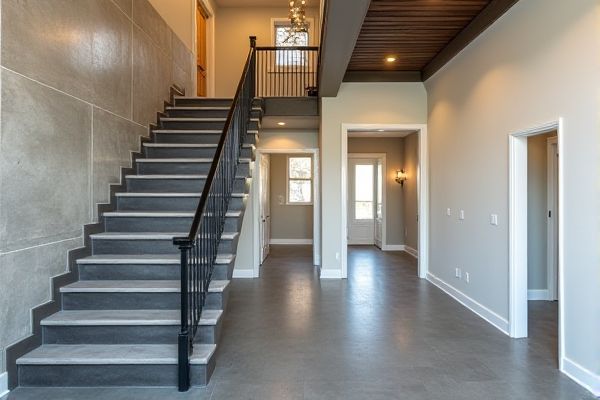
Prefab metal stairs offer faster installation and consistent quality due to factory fabrication, while site-built stairs provide greater customization and adaptability to unique architectural designs. Explore the advantages and drawbacks of each option to determine which type best suits Your construction needs.
Table of Comparison
| Feature | Prefab Metal Stairs | Site-Built Stairs |
|---|---|---|
| Construction Time | Fast installation, delivered pre-assembled or ready to install | Longer build time, constructed entirely on-site |
| Cost | Generally lower due to standardized production | Higher labor and material costs due to customization |
| Customization | Limited to preset designs and sizes | Highly customizable to fit unique spaces and designs |
| Durability | High durability, resistant to weather and wear | Depends on materials used; wood may require maintenance |
| Quality Control | Factory-controlled standards | Variable, reliant on on-site craftsmanship |
| Installation Complexity | Less complex, minimal on-site labor | More complex, requires skilled labor and tools |
Overview of Prefab Metal Stairs
Prefab metal stairs offer a high-quality, efficient alternative to site-built stairs by being manufactured in controlled factory settings, ensuring consistent materials and precise assembly. These stairs are fabricated from durable metals such as steel or aluminum, providing enhanced strength, fire resistance, and low maintenance compared to traditional wood or concrete options. Prefabricated metal stairs reduce on-site construction time, minimize labor costs, and facilitate easier installation, making them ideal for commercial, industrial, and modern architectural projects.
Overview of Site-Built Stairs
Site-built stairs offer customization to fit unique architectural designs and specific site conditions, allowing precise adjustments for irregular spaces. Constructed on location using materials like wood, concrete, or metal, these stairs can be tailored for exact dimensions, finishes, and structural requirements. This flexibility supports integration with existing structures but often requires longer construction time and increased labor costs compared to prefab metal stairs.
Cost Comparison: Prefab vs Site-Built
Prefab metal stairs typically offer a lower overall cost compared to site-built stairs due to reduced labor expenses and faster installation times. Site-built stairs often incur higher costs from on-site fabrication, customization, and longer construction durations. Material quality consistency and factory-controlled manufacturing processes in prefab stairs contribute to cost savings and minimize potential rework.
Installation Time and Process
Prefab metal stairs significantly reduce installation time compared to site-built stairs by arriving pre-fabricated and ready for quick assembly, often taking just a few hours to install. Site-built stairs require extensive on-site measurements, cutting, welding, and fitting, which can extend the process to several days and increase labor costs. The streamlined installation process of prefab metal stairs minimizes disruption and ensures consistent quality control.
Durability and Material Quality
Prefab metal stairs are manufactured under controlled conditions using high-grade steel or aluminum, ensuring consistent durability and resistance to corrosion, wear, and impact. Site-built stairs may vary in material quality depending on local sourcing and craftsmanship, potentially leading to inconsistencies in strength and longevity. Choosing prefab metal stairs guarantees your structure benefits from superior material quality and long-term durability compared to site-built alternatives.
Customization Options Available
Prefab metal stairs offer a range of customization options including adjustable dimensions, finishes like powder coating or galvanization, and modular designs for easy installation. Site-built stairs provide maximum flexibility for unique architectural details and can be tailored precisely to your space, materials, and aesthetic preferences. Your choice depends on whether you prioritize quick assembly or personalized design intricacies.
Safety and Building Code Compliance
Prefab metal stairs offer consistent safety features and are manufactured to meet stringent building code compliance, ensuring uniform quality and structural integrity. Site-built stairs may vary in precision and require thorough inspections to guarantee they adhere to safety standards and local codes. Choosing prefab metal stairs can streamline compliance processes and enhance your project's overall safety assurance.
Maintenance Requirements
Prefab metal stairs require minimal maintenance due to their factory-applied coatings and rust-resistant materials, reducing the need for frequent repairs or repainting. Site-built stairs often demand ongoing upkeep because of potential wood warping, moisture damage, and inconsistent finishes. You can save time and long-term costs with prefab metal stairs by avoiding the common maintenance challenges associated with traditional site-built stair construction.
Aesthetic Considerations
Prefab metal stairs offer sleek, modern aesthetics with precise factory finishes and consistent design elements, enhancing contemporary architectural spaces. Site-built stairs provide customizable options tailored to unique spatial requirements and stylistic preferences, allowing for personalized craftsmanship and material choices. Your decision should consider the desired visual impact and how seamlessly the stairs integrate with the overall design theme.
Ideal Applications and Use Cases
Prefab metal stairs are ideal for commercial buildings, industrial facilities, and outdoor environments where durability and quick installation are crucial. Site-built stairs excel in custom residential projects or unique architectural designs requiring precise dimensions and aesthetic flexibility. Your choice depends on project timelines, design requirements, and installation conditions.
 homyna.com
homyna.com